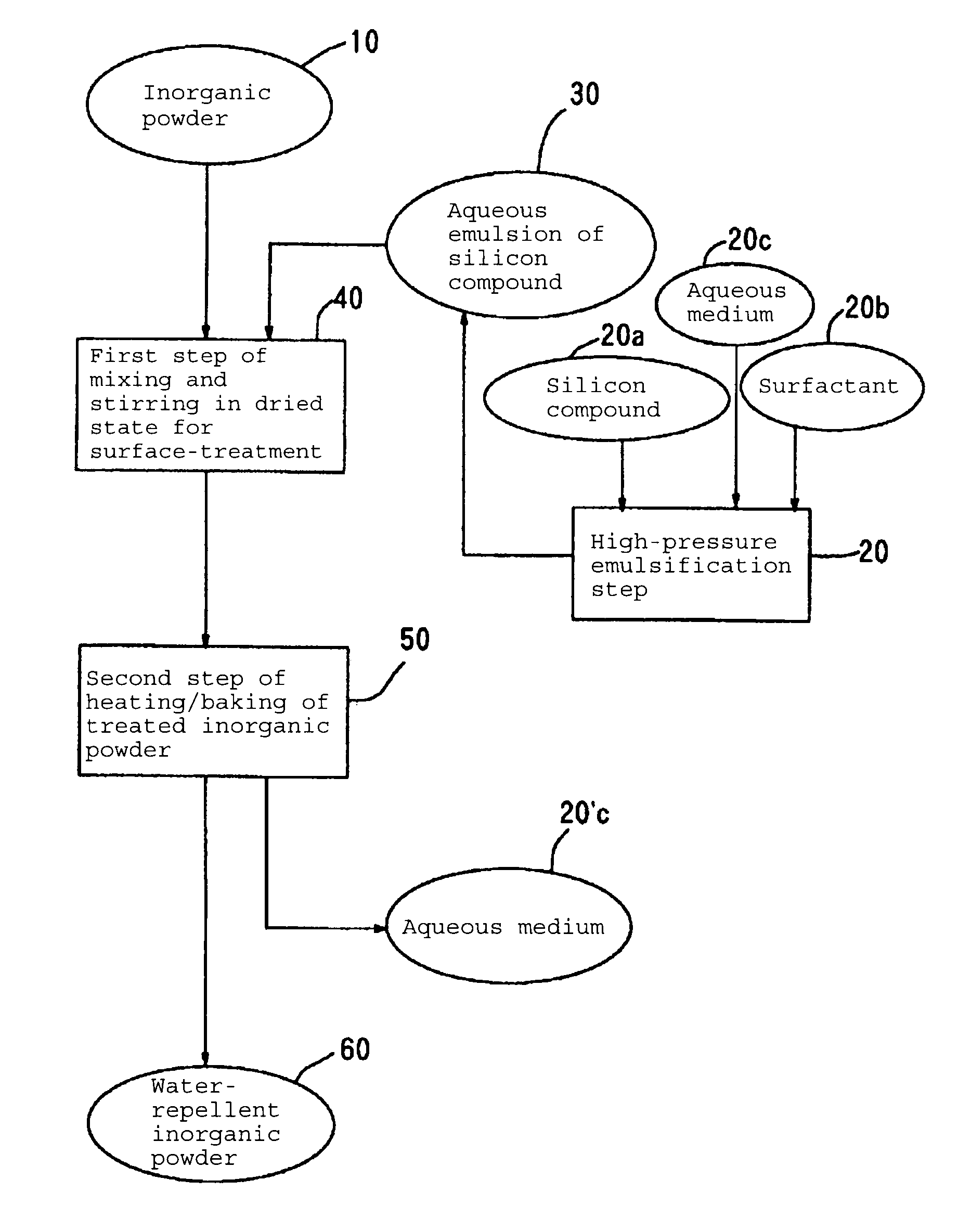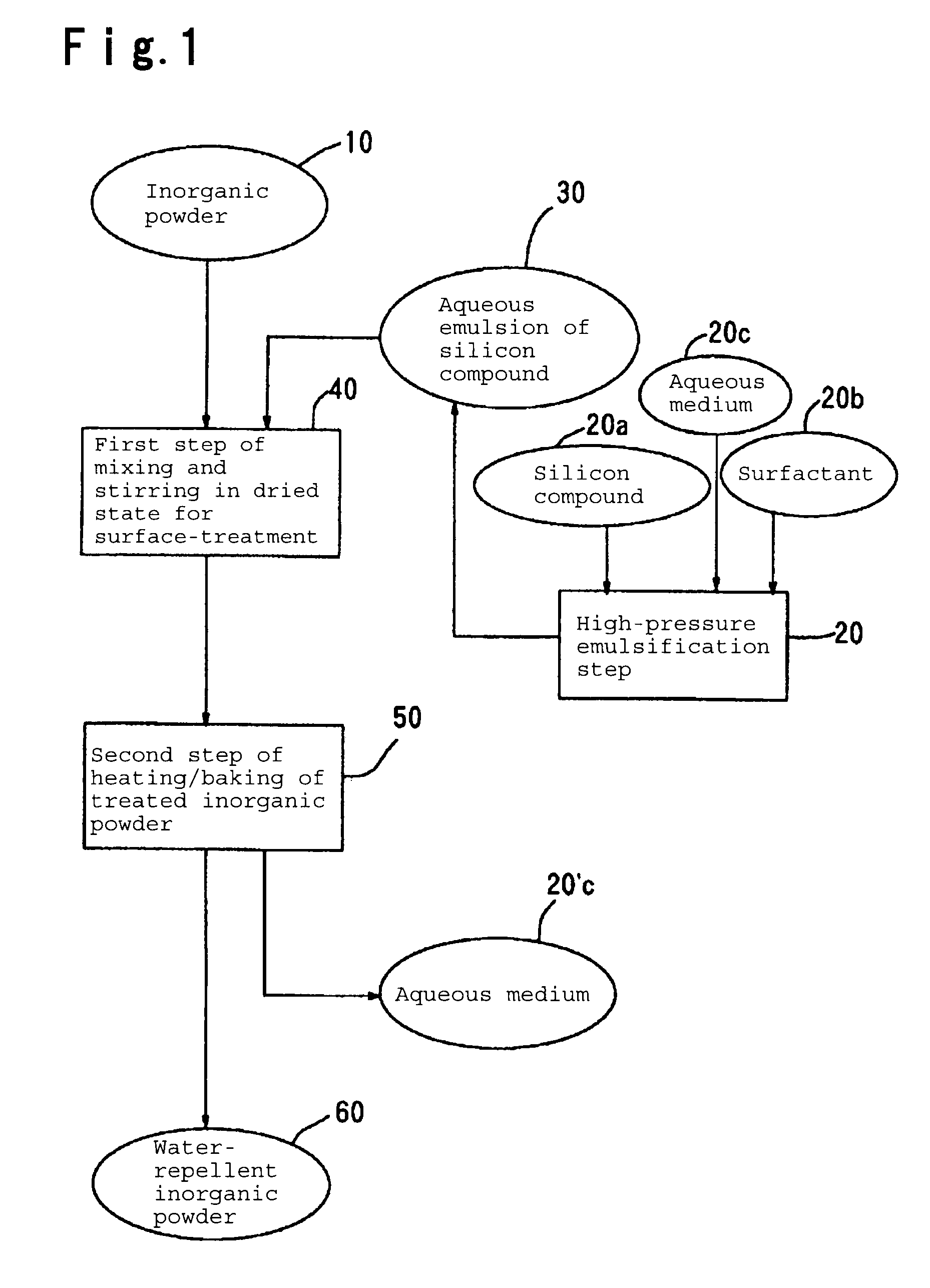Water-repellent inorganic powder and process for its production
a technology of inorganic powder and water repellent, which is applied in the direction of chemistry apparatus and processes, silicon oxides, silicon compounds, etc., can solve the problems of inability to discharge organic solvents to the atmosphere, inability to achieve adequate water repellency, and difficulty in surface treatment while maintaining the shape of particles, etc., to achieve stable water repellency
- Summary
- Abstract
- Description
- Claims
- Application Information
AI Technical Summary
Benefits of technology
Problems solved by technology
Method used
Image
Examples
preparation example 1
Preparation of Emulsion of Silicone Oil having a Group Reactive with Inorganic Powder
[0100]As the silicone oil, an ethoxy-modified silicone oil having a group reactive with a silanol group of silica (tradename: KF-9909, manufactured by Shin-Etsu Silicones, kinetic viscosity: 20 mm2 / s) was selected. In 500 g of the silicone oil, 75 g of a polyoxyethylene fatty acid ester (tradename: IONET MO-600, manufactured by Sanyo Chemical Industries Ltd.) was dissolved as a surfactant to obtain a solution, to which 425 ml of deionized water was added.
[0101]This mixed solution was preliminarily emulsified at 10,000 rpm for 15 minutes by T.K.HOMO MIXER (manufactured by Tokushu Kika Kogyo K.K.). Such a preliminarily emulsified liquid was emulsified by 4-pass treatment by a pass-through type generator having an orifice diameter of 120 μm under a pressure of 120 MPa by means of a high pressure emulsifier (machine name: Nanomaizer mark II, model: NM-2-L200, manufactured by YOSHIDA KIKAI CO., LTD.).
[01...
preparation example 2
Preparation of Emulsion of Silicone Oil having no Group Reactive with Inorganic Powder
[0103]As the silicone oil, dimethyl silicone oil (tradename: KF-96-100CS, kinetic viscosity: 100 mm2 / s, manufactured by Shin-Etsu Silicones) was selected. In 500 g of such silicone oil, 74 g of a polyoxyethylene fatty acid ester (tradename: IONET MO-600, manufactured by Sanyo Chemical Industries Ltd.) was dissolved as a surfactant to obtain a solution, to which 425 ml of deionized water was added.
[0104]This mixture was preliminarily emulsified at 10,000 rpm for 15 minutes by T.K.HOMO MIXER (manufactured by Tokushu Kika Kogyo K.K.). Such a preliminarily emulsified liquid was emulsified by 4-pass treatment by a pass-through type generator having an orifice diameter of 120 μm under a pressure of 120 MPa by means of a high pressure emulsifying machine (machine name: Nanomaizer mark II, model: NM2-L200, manufactured by YOSHIDA KIKAI CO., LTD.).
[0105]The average particle size of such emulsified emulsion ...
example 1
[0106](1) As an inorganic powder to be surface-treated, 30 g of spherical silica gel (average particle diameter: 5 μm, specific surface area: 756 m2 / g, pore volume: 0.88 ml / g) was used. Further, 0.3 g of the aqueous emulsion of an ethoxy-modified silicone oil prepared in Preparation Example 1 was preliminarily diluted with 26.1 ml of deionized water. Here, the mass ratio, based on solid content, of silica gel:silicone oil emulsion (calculated as silicone oil solid content)=100: 0.5.
[0107](2) The inorganic powder was introduced into a polyethylene container having a capacity of 1,000 mL, which was set on a tumbler shaker mixer (manufactured by SHINMARU ENTERPRISES CORPORATION) as a powder mixing machine. While the above mentioned silicone oil emulsion was dividedly added, the powder was thoroughly mixed for 30 minutes for surface treatment in a powder state.
[0108](3) The surface-treated powder mixture was heated to 120° C. and dried for 3 hours to obtain the desired silica gel treate...
PUM
| Property | Measurement | Unit |
|---|---|---|
| pressure | aaaaa | aaaaa |
| diameter | aaaaa | aaaaa |
| speed | aaaaa | aaaaa |
Abstract
Description
Claims
Application Information
 Login to View More
Login to View More - R&D
- Intellectual Property
- Life Sciences
- Materials
- Tech Scout
- Unparalleled Data Quality
- Higher Quality Content
- 60% Fewer Hallucinations
Browse by: Latest US Patents, China's latest patents, Technical Efficacy Thesaurus, Application Domain, Technology Topic, Popular Technical Reports.
© 2025 PatSnap. All rights reserved.Legal|Privacy policy|Modern Slavery Act Transparency Statement|Sitemap|About US| Contact US: help@patsnap.com



